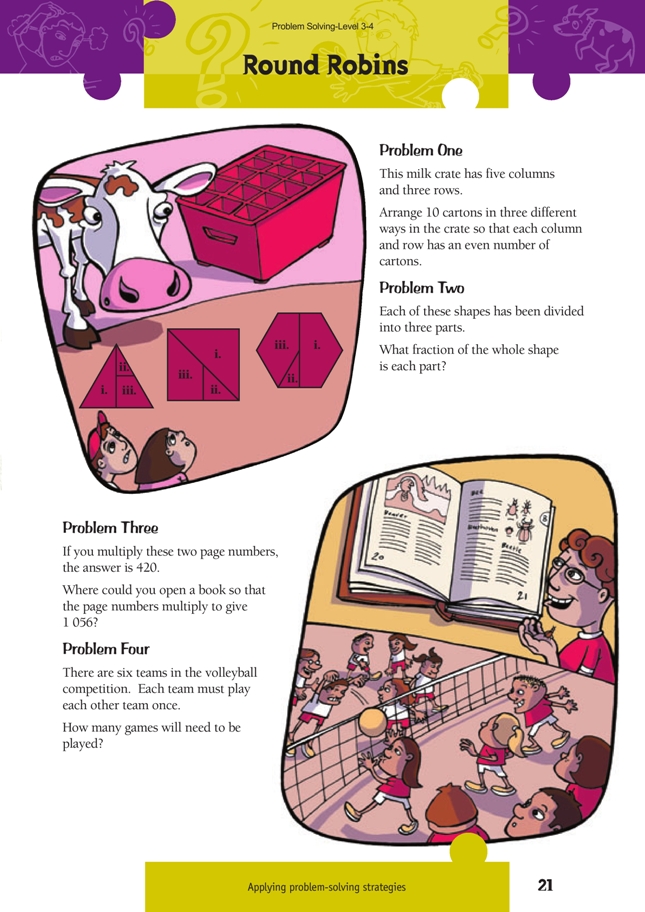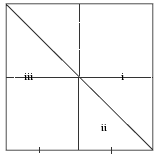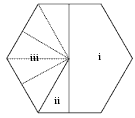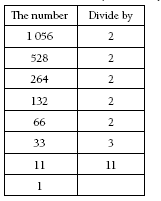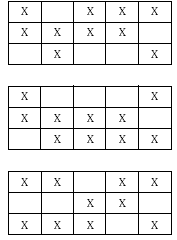These are level 3 number and statistics problems from the Figure It Out series.
A PDF of the student activity is included.
Click on the image to enlarge it. Click again to close. Download PDF (297 KB)
find fractions of a region (Problem 2)
use prime factors or square roots to solve problems (Problem 3)
find outcomes using a diagram (Problem 4)
FIO, Levels 3-4, Problem Solving, Round Robins, page 21
Problem One
There are many possible answers for this. The students can experiment with equipment or diagrams and discuss their approaches with one another. For example, they could discuss how many cartons there are in each row and column and whether they find a rule for arranging the cartons.
There isn’t room for more than five cartons in each row, so the possible even numbers in each row are two and four. There are 10 cartons altogether, so there must be two rows of four and one row of two. Similarly, the only possible even number of cartons in a column is two, so there must be two cartons in each column.
Here’s one answer, starting with two cartons in the top row:
When you put four cartons in the second row, you can’t have two of them in the same columns as the first two cartons. If you do, you’ll force three in a column when you put the last four cartons in. Therefore, you must have something like the situation below:
Then the final four cartons go in like this:
Every other possible answer is obtained in the same way. Put two cartons in any row. Then add the remaining cartons. In the last two rows, you’ll have three cartons in the columns not occupied by the first two cartons. You’ll also have one carton in each of these last rows aligned in a column with one of the original two cartons.
Problem Two
This problem draws on the students’ knowledge of geometry and symmetry and requires them to visualise fractions of shapes. Drawing diagrams or cutting up the shapes will help this visualisation. The students will visualise the fractions in different ways depending on what makes most sense to them. The way they visualise does not matter as long as they check that their visualisation is correct. In the methods discussed below, each is visualised in a slightly different way.
The half in the triangle should be easy for students to see. The vertical line runs down the centre of the triangle and cuts it in half. What is the next part that is easy to recognise? The students may notice that part ii will fit into half the triangle four times, so it must be 1/4 of 1/2, which is 1/8. Parts ii and iii make up 1/2, so iii must be 3/8 (1/8 + 3/8 = 4/8, and 4/8 = 1/2).
Once again, the half of the square should be easy to see. The diagonal line is a mirror line that cuts the square in half. Part ii must be 1/8 because it is half of 1/4 of the square. Part iii must be 3/8 because it is a whole quarter plus another 1/8.
The diagram shows the square divided into quarters.
Part i of the hexagon is also a half. (This may be slightly harder to see than a hexagon divided in half with a line from vertex to vertex and resulting in two trapezia.) A student cutting up the shape will find that ii fits into the hexagon 12 times, so it must be 1/12. Part iii must be 5/12 because 1/2 – 1/12 = 5/12.
Problem Three
The students need to look for two consecutive factors of 1 056. They could use trial and improvement by starting from a known multiplication fact that gives a product that is close to 1 056. For example, if they look at 30 x 30 = 900, this will tell them that the two numbers will be a bit higher than 30. However, as factors form an important part of mathematical thinking, it is better for the students to use them to solve this problem.
To find the prime factors of any large number, divide by the smallest possible factor (2 if it is an even number). Divide the result again by the smallest possible factor. Keep doing this until you arrive at 1. A table layout is a very useful way to do this:
The right column shows that 1 056 = 2 x 2 x 2 x 2 x 2 x 3 x 11. The diagram below shows these factors as two groups:
Another check is to note that the left-hand page of a book always has an even page number and the right hand always has an odd page number, so the even number in the answer should be smaller than the odd.
Extension
Challenge the students to find the consecutive pages that have a product of 2 352 (48 and 49). The prime factors of 2 352 are 2 x 2 x 2 x 2 x 3 x 7 x 7.
Problem Four
This is the same problem as Problem Two, page 20, but the tracks have been changed to games. There are six teams, so there will be 1/2 x 6 x 5 = 15 games.
Hints for Students
1. How can you make up 10 with even numbers?
How many cartons will go in each column? How many will go in each row?
2. Use equipment or a drawing.
Cut up the shapes. Start with the fractions that you do know.
3. Notice that the page numbers are consecutive numbers.
4. You could draw a diagram.
Can you see a quick way to count the games?
Remember the Circuit Island tracks in Problem Two, page 20?
Answers to Problems
1. There are 60 possible solutions. All will have one row that has only two cartons in it. Three of the solutions are:
2. a. i is 1/2, ii is 1/8, and iii is 3/8.
b. i is 1/2, ii is 1/8, and iii is 3/8.
c. i is 1/2, ii is 1/12, and iii is 5/12.
3. 32 and 33
4. 15 games
